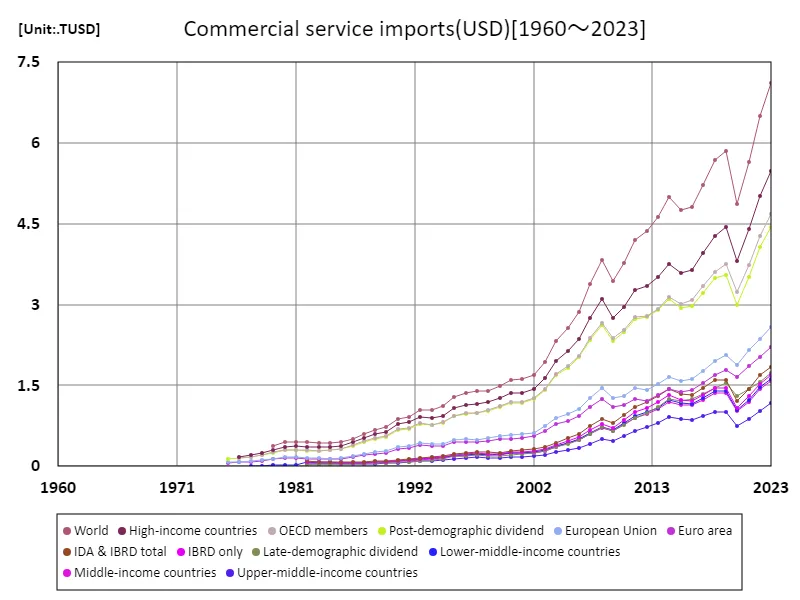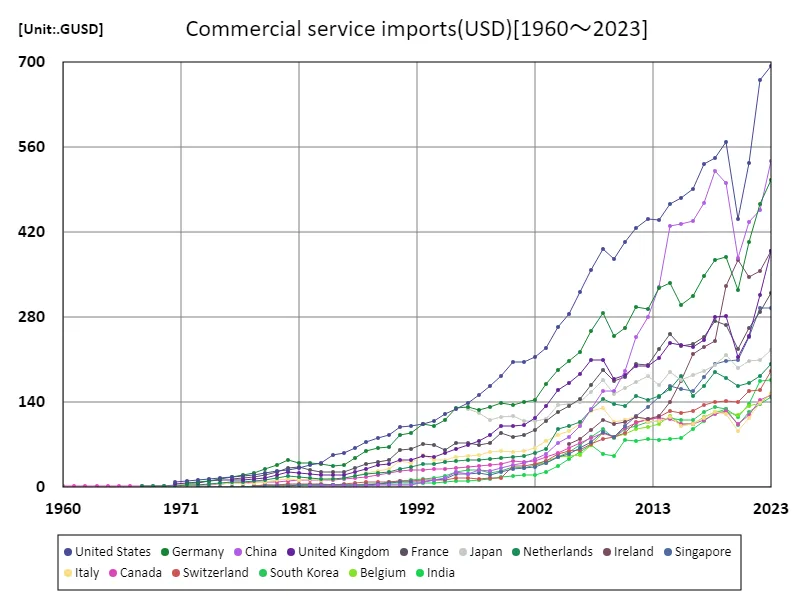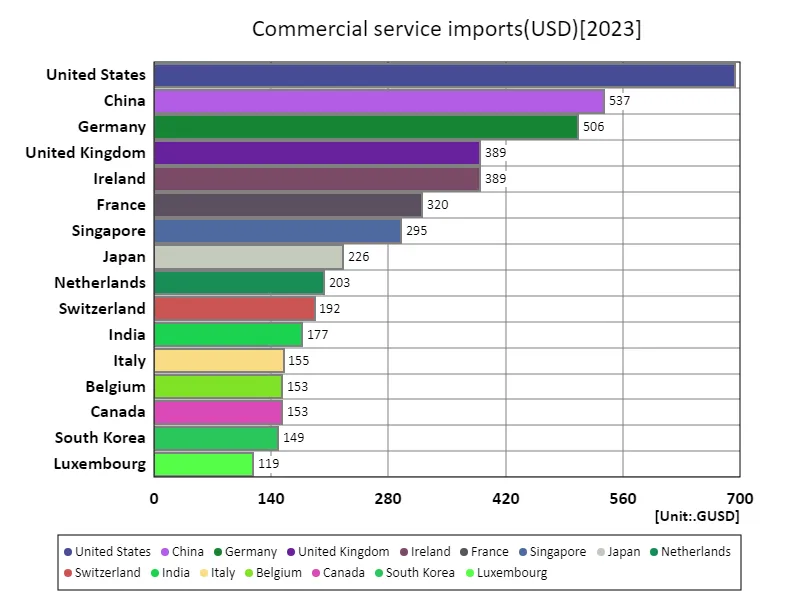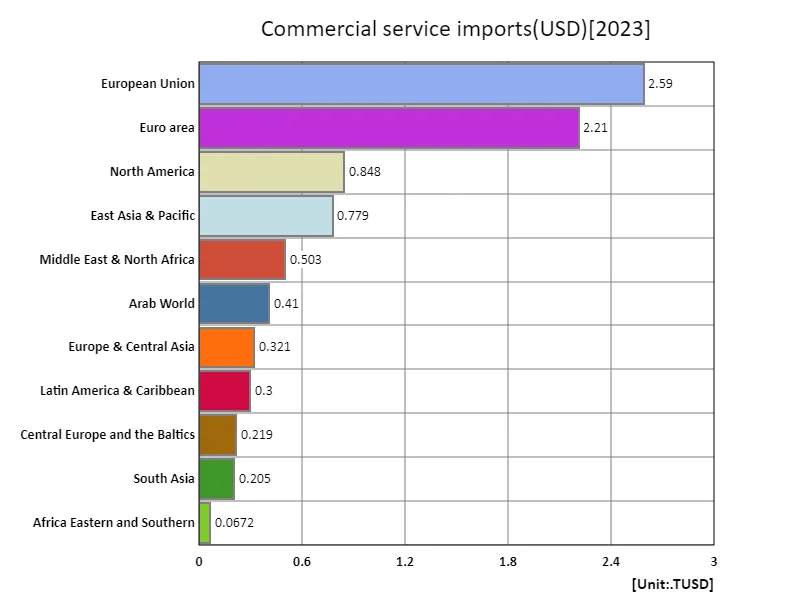Abstract
Imports of commercial services play a significant role in the global economy, reaching USD 7.12 trillion worldwide as per 2023 data. This trend is especially accelerated by the rapid development of digital technologies and financial services. In recent years, the import value of commercial services has been growing sustainably as demand for digital services increases and multinational companies increasingly outsource services. This increase is also being driven by the growth of emerging markets, which are accelerating the international distribution of commercial services as part of the global business ecosystem. Economic globalization and technological advances are likely to continue to support this trend.
Commercial services imports (usd)
Imports of commercial services have grown sharply since 1960, reaching USD 7.12 trillion globally in 2023, 100% of their peak. In the early stages, international trade in commercial services was relatively low and relied mainly on imports and exports. However, with the globalization of the economy and advances in information technology in the 1970s and 1980s, the international distribution of services increased rapidly. In the 1990s, the advancement of the Internet and digitalization further boosted imports of commercial services, leading to prominent outsourcing and offshoring trends by multinational corporations. Since the 2000s, demand for commercial services has surged, especially in areas such as finance, IT, and business process outsourcing, driving the increase in import values. Additionally, economic growth in developing countries and a growing middle class are supporting rising imports of services. Going forward, progress in digitalization and global economic cooperation is expected to further promote international trade in commercial services, leading to continued growth.


The maximum is the latest one, 7.12TUSD of World
Commercial services imports (usd) (worldwide)
Imports of commercial services have been a significant growth driver in the U.S. economy since the 1960s. US commercial services imports will reach US$694 billion in 2023, 100% of the peak. This shows that the American economy is highly dependent on the service sector. In the 1960s, the United States had relatively limited imports of commercial services and was primarily a manufacturing economy. As demand for domestic services increased, the United States gradually expanded its intake of foreign services. From the 1980s to the 1990s, the globalization of IT and financial services progressed, leading to a surge in imports of American commercial services. In particular, outsourcing in areas such as information technology (IT), finance, and consulting has become more prominent, driving the increase in service imports. In the 2000s, with the advancement of digitalization, American companies began to adopt more and more services from overseas in an effort to reduce costs and improve efficiency. As a result, U.S. imports of commercial services have peaked and play a key role in the global economy. The expansion of global service networks and advances in digital technology are expected to continue to support U.S. imports of commercial services.


The maximum is the latest one, 694GUSD of United States
Commercial services imports (usd) (world countries, latest year)
Imports of commercial services were the highest in the world in 2023, with the United States recording USD 694 billion, for an overall total of USD 6.57 trillion and an average of USD 5.76 billion. These data point to the expansion of the global services economy. This trend, which began in the 1960s, has accelerated in recent years, especially with the advancement of digitalization and globalization. The high value of America’s commercial services imports reflects the size of the domestic market and diverse demand for services, with outsourcing in areas such as IT, finance and consulting being a major driver. The United States has adopted many foreign services in order to improve service efficiency and reduce costs, and this trend has led to an increase in the amount of imports. However, the overall total of USD 6.57 trillion and average of USD 5.76 billion indicates that demand for commercial services is not evenly distributed globally, but varies depending on the size of the economy and its stage of development. Developed countries in particular recorded high import volumes, and emerging markets are also growing, but the overall balance varies by region. Going forward, the expansion of global service networks and technological innovation are expected to further drive imports of commercial services.


The maximum is 694GUSD of United States, the average is 57.6GUSD, and the total is 6.57TUSD
Commercial services imports (usd) (region, latest year)
According to 2023 data, the European Union (EU) recorded commercial services imports of USD 2.59 trillion, compared with an overall total of USD 8.46 trillion and an average of USD 76.9 billion. These figures indicate that international trade in commercial services continues to play an important role. The European Union’s high import figures are due to the size of its economy and its diverse demand for services. The EU supports domestic and international economic activity by importing a variety of services from abroad, including finance, IT, consulting and law. In particular, as economic integration progresses within the EU, the international distribution of services is being promoted and trade in services between countries is becoming more active. Meanwhile, the total of USD 8.46 trillion and the average of USD 76.9 billion indicate that imports of commercial services are widespread across the globe. In particular, developed countries recorded high import values, reflecting the importance of services in the global business environment. Emerging markets are also experiencing growth, but the size of their import volumes varies by region. Going forward, technological innovation and increasing global economic integration are likely to continue to influence imports of commercial services.


The maximum is 2.59TUSD of European Union, the average is 769GUSD, and the total is 8.46TUSD



Comments